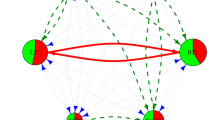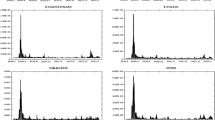Abstract
Network to Transaction (NVT) ratio is a measure that describes the relationship between transaction volume and market capitalization, and that may serve as an indicator for the valuation of a cryptocurrency. We build a connectedness network connecting 39 cryptocurrencies based on mutual contributions to the variances of forecast errors for NVT ratios. We find that NVT connectedness is not related to market capitalization, as we have large and small cryptocurrencies by market cap that propagate large NVT shocks (e.g. Litecoin, Dogecoin, Bitcoin Cash(bch), OMG Network and Decentraland). The largest transmitter of NVT shocks is OMG Network, which receives little public attention. Cryptocurrencies relying on proof of stake as a consensus mechanism are the smallest receivers of NVT spillovers from other cryptocurrencies. These assets are also the least interconnected, which makes them attractive from a risk diversification point of view. This complements the energy efficiency of PoS compared with proof of work.








Similar content being viewed by others
References
Bouri, E., Molnar, P., Azzi, G., Roubaud, D., & Hagfors, L. I. (2017). On the hedge and safe haven properties of Bitcoin: Is it really more than a diversifier? Finance Research Letters, 20, 192–198.
Cheah, E-T., & Fry, J. (2015). Speculative bubbles in bitcoin markets? An empirical investigation into the fundamental value of bitcoin. Economics Letters, 130, 32–36.
Chen, C. Y. H., Després, R., Guo, L., & Renault, T. (2018). What Makes Cryptocurrencies Special? Investor Sentiment and Price Predictability in the Absence of Fundamental Value. Discussion Paper Sfb 649. Unpublished work.
Chen, C.Y. H., & Hafner, C. M. (2019). Sentiment-induced bubbles in the cryptocurrency market. Journal of Risk and Financial Management, 12(2), 53.
Cheung, A., Roca, E., & Su, J-J. (2015). Crypto-currency bubbles: An application of the Phillips-Shi-Yu (2013) methodology on Mt.Gox bitcoin prices. Applied Economics, 47, 2348–58.
Corbet, S., Brian, L., & Larisa, Y. (2018). Datestamping the bitcoin and ethereum bubbles. Finance Research Letters, 26, 81–88.
Corbet, S., Meegan, A., Larkin, C., Lucey, B., & Yarovaya, L. (2018). Exploring the dynamic relationships between cryptocurrencies and other financial assets. Economics Letters, 165, 28–34.
Diebold, F. X., & Yilmaz, K. (2009). Measuring financial asset return and volatility spillovers, with application to global equity markets. The Economic Journal, 119, 158–171.
Diebold, F. X., & Yilmaz, K. (2012). Better to give than to receive: Predictive directional measurement of volatility spillovers. International Journal of Forecasting, 28, 57–66.
Diebold, F. X., & Yilmaz, K. (2014). On the network topology of variance decompositions: Measuring the connectedness of financial firms. Journal of Econometrics, 182, 119–134.
Elendner, T., Ong, B., & Lee, T. M. (2016). The Cross-Section of Crypto- Currencies as Financial Assets: An Overview. SFB discussion paper, Humboldt University Berlin.
Fry, J., & Cheah, E. T. (2016). Negative bubbles and shocks in cryptocurrency markets. International Review of Financial Analysis, 47, 343–352.
Hafner, C. (2020). Testing for bubbles in cryptocurrencies with time-varying volatility. Journal of Financial Econometrics, 18(2), 233–249.
Hafner, C. M., Herwartz, H., & Maxand, S. (2022). Identification of structural multivariate GARCH models. Journal of Econometrics, 227, 212–227.
Hafner, C. M., & Herwartz, H. (2021). Dynamic score driven independent component analysis. Journal of Business & Economic Statistics. https://doi.org/10.1080/07350015.2021.2013244.
Härdle, W. K., Harvey, C., & Reule, R. (2020). Understanding cryptocurrencies. Journal of Financial Econometrics, 18, 181–208.
Kjaerland, F., Khazal, A., Krogstad, E. A., Nordstroem, F. B. G., & Oust, A. (2018). An analysis of bitcoin’s price dynamics. Journal of Risk and Financial Management, 11, 63.
Koop, G., Pesaran, M. H., & Potter, S. M. (1996). Impulse response analysis in nonlinear multivariate models. Journal of Econometrics, 74, 119–147.
Lehner, E., Ziegler, J. R., & Carter, L. (2021). A call for second-generation cryptocurrency valuation metrics. In: Research Anthology on Blockchain Technology in Business, Healthcare, Education, and Government (pp. 722–742). IGI Global.
Lütkepohl, H. (2005). New introduction to multiple time series analysis. Springer Verlag.
Nasekin, S., & Chen, C. Y-H. (2018). Deep learning-based cryptocurrency sentiment construction. Journal of Risk and Financial Management, 12, 53. Available at SSRN 3310784.
Oliveira, L., Zavolokina, L., Bauer, I., & Schwabe, G. (2018). To token or not to token: Tools for understanding blockchain tokens. In: International Conference of Information Systems (ICIS 2018), San Francisco, U.S.A.
Petukhina, A., Trimborn, S., Härdle, W. K. & Elendner, H. (2020). Investing with Cryptocurrencies – Evaluating their potential for portfolio allocation strategies. Quantitative Finance https://doi.org/10.2139/ssrn.3274193
Phillips, P. C. B., Shi, S., & Yu, J. (2015). Testing for multiple bubbles: Historical episodes of exuberance and collapse in the S &P 500. International Economic Review, 56, 1043–78.
Phillips, P. C. B., Wu, Y., & Yu, J. (2011). Explosive behavior in the 1990s nasdaq: When did exuberance escalate asset values? International Economic Review, 52, 201–26.
Pesaran, H. H., & Shin, Y. (1998). Generalized impulse response analysis in linear multivariate models. Economics Letters, 58, 17–29.
Saleh, F. (2021). Blockchain without waste: Proof-of-stake. The Review of Financial Studies, 34(3), 1156–1190.
Sims, C. A. (1980). Macroeconomics and reality. Econometrica, 48, 1–48.
Trimborn, S., Li, M., & Härdle, W. K. (2020). Investing with cryptocurrencies–A liquidity constrained investment approach. Journal of Financial Econometrics, 18(2), 280–306.
Yi, S., Xu, Z., & Wang, G. (2018). Volatility connectedness in the cryptocurrency market: Is Bitcoin a dominant cryptocurrency? International Review of Financial Analysis, 60(C), 98–114.
Author information
Authors and Affiliations
Corresponding author
Additional information
Publisher's Note
Springer Nature remains neutral with regard to jurisdictional claims in published maps and institutional affiliations.
Appendix
Appendix
See Figs. 9, 10, 11, 12, 13 and Tables 5 and 6.
Rights and permissions
About this article
Cite this article
Hafner, C.M., Majeri, S. Analysis of cryptocurrency connectedness based on network to transaction volume ratios. Digit Finance 4, 187–216 (2022). https://doi.org/10.1007/s42521-022-00054-w
Received:
Accepted:
Published:
Issue Date:
DOI: https://doi.org/10.1007/s42521-022-00054-w









